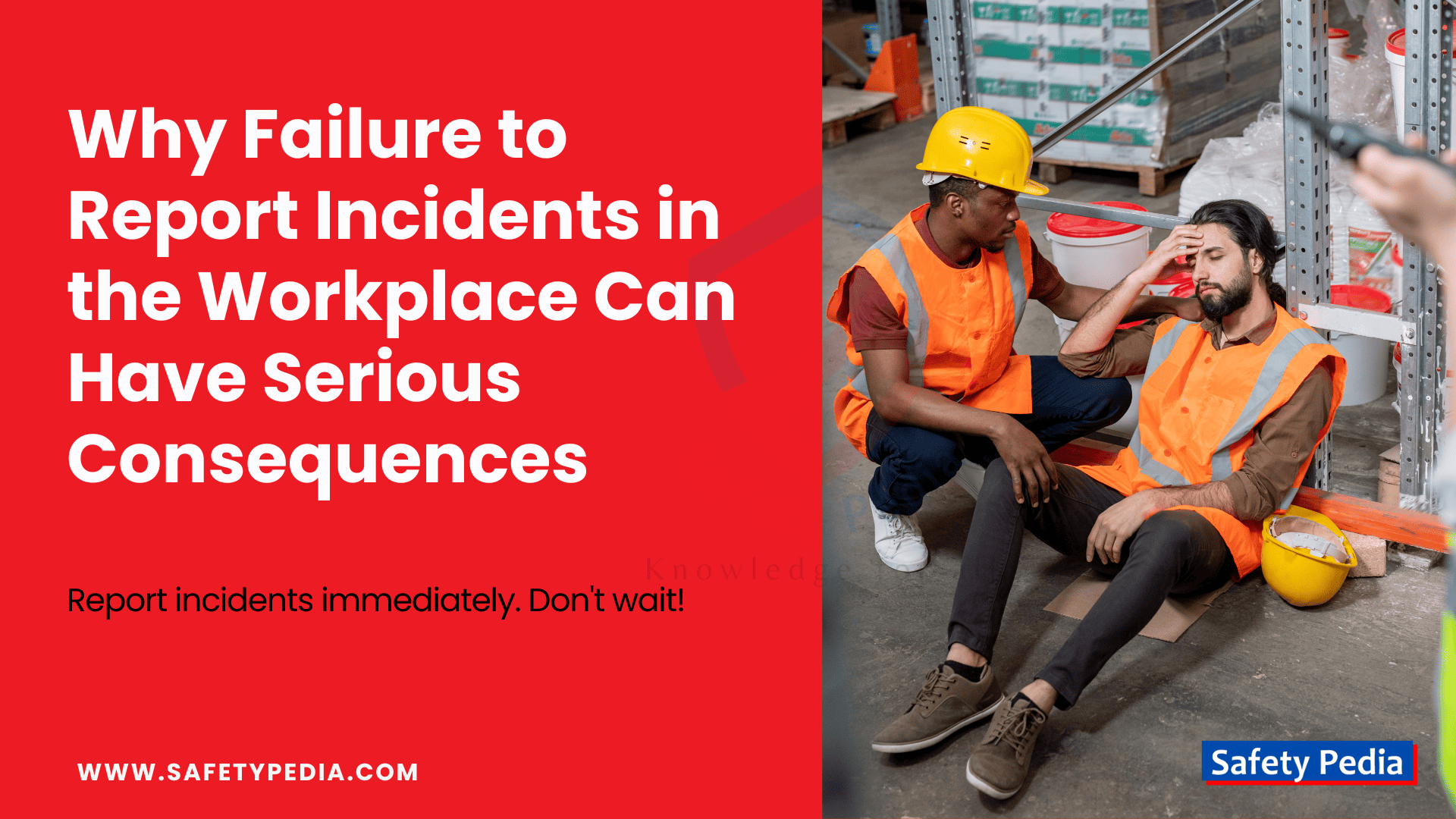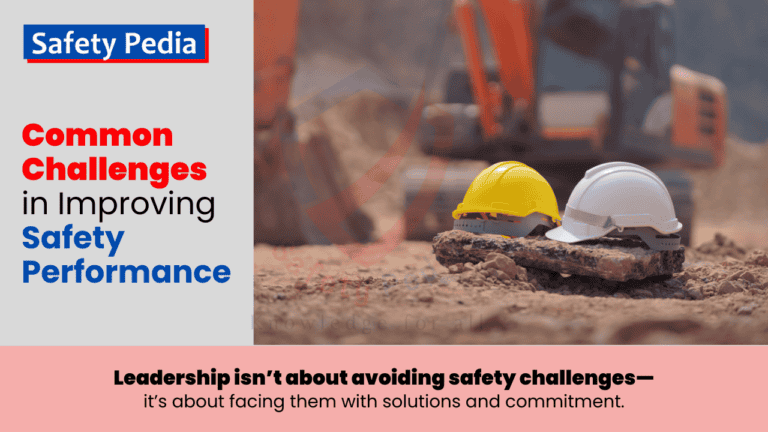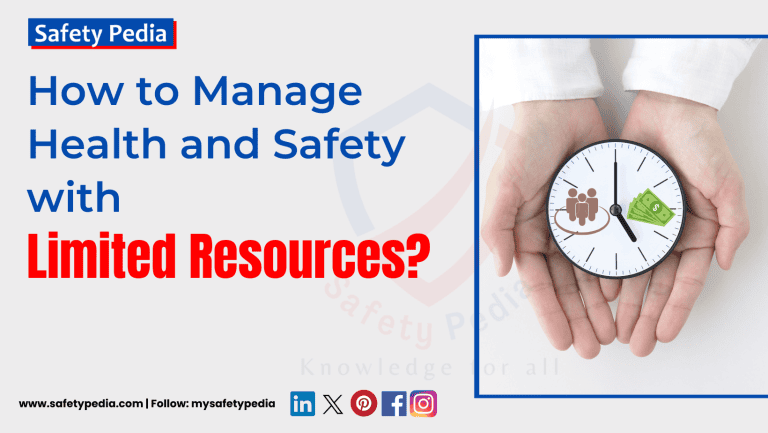
In today’s workplace, maintaining a culture of open communication and transparency is essential. Unfortunately, there is a hidden danger that often goes unnoticed – the failure to report incidents in the workplace. Whether it’s a safety violation, near miss, or accident, turning a blind eye to these issues can have serious consequences for both employees and the organization as a whole.
The consequences of silence can range from decreased employee morale and trust to an increased risk of legal action and reputational damage. When incidents go unreported, it perpetuates a culture of fear and secrecy, allowing problems to fester and potentially escalate. This not only puts employees at risk but also makes it difficult for organizations to address and resolve issues effectively.
Workplace incidents are any unplanned events that result in injury, illness, damage or loss. They can range from minor slips and falls to major accidents and fatalities. Workplace incidents are not only harmful to the workers involved, but also to the employers, customers, suppliers and the public.
Reporting workplace incidents is a legal and ethical obligation for both employers and employees. It is also a crucial step in preventing similar incidents from happening again. Reporting workplace incidents can help identify the root causes, implement corrective actions, improve safety standards, reduce costs and liabilities, and enhance the reputation of the organization.
However, many workplace incidents go unreported for various reasons. Some workers may fear retaliation, blame, or disciplinary actions from their employers or co-workers. Some workers may not be aware of their rights and responsibilities, or the reporting procedures and channels. Some workers may think that reporting incidents is not worth the hassle, or that their incidents are too minor or insignificant to report.
By encouraging employees to speak up and report any incidents, organizations can create a safer and more inclusive work environment. Implementing a reporting system that protects and supports individuals who come forward is crucial. It is equally important for employers to take reports seriously and respond promptly and appropriately. In this article, we will explore the hidden dangers of silence in the workplace, the potential consequences for individuals and organizations, and strategies for promoting a culture of reporting and accountability.
Additionally, employers who fail to prioritize incident reporting and investigation risk being held liable for negligence.
Reporting incidents is not only an ethical responsibility but also a legal obligation in many cases. Failure to report can lead to serious consequences, including potential liability for the organization and personal consequences for individuals involved.
The importance of incident reporting in the workplace
Incident reporting is a critical component of maintaining a safe and healthy workplace. By reporting incidents promptly, employees can help prevent further harm and ensure that appropriate actions are taken to address the issue. Incident reports serve as a valuable source of information for finding causes, identifying patterns, implementing corrective measures, and improving overall safety protocols.
Furthermore, incident reporting is also essential for regulatory compliance. Many industries and jurisdictions have specific requirements for reporting incidents, particularly those involving health and safety hazards. Failure to comply with these reporting obligations can result in severe penalties, fines, and legal liabilities for both the organization and individuals involved.
Definition of an incident and its different types
An incident is an unplanned event that disrupts the normal operation of a system, service, or process, and causes or may cause harm to people, property, or the environment. Incidents can be classified into different types according to their cause, impact, severity, or response. Some common types of incidents are:
Safety incidents: These are incidents that result in injury, illness, or death of people, such as accidents, fires, explosions, or exposure to hazardous substances.
Medical incidents: These are events that occur during medical care that could harm a patient. Examples include medication errors, infections, and surgical complications.
Security incidents: These are incidents that compromise the confidentiality, integrity, or availability of information assets, such as data breaches, cyberattacks, or unauthorized access.
Environmental incidents: These are incidents that cause damage to the natural environment, such as pollution, spills, leaks, or waste disposal.
Road traffic accident: An incident that involves a collision between vehicles, pedestrians, cyclists or animals on a public road or highway.
Near miss: An incident that could have resulted in harm, loss or damage, but was avoided by chance or timely intervention.
Dangerous occurrence: An incident that poses a serious and immediate risk to health, safety or the environment, such as a fire, explosion, gas leak or structural collapse.
The consequences of Failure to report incidents in the workplace
Choosing not to report incidents in the workplace can have serious consequences that extend beyond the immediate incident. By keeping silent, employees inadvertently enable a culture of secrecy and cover-up, which can perpetuate a cycle of misconduct. This can lead to a loss of trust among employees, erode morale, and create a toxic work environment that hinders productivity and innovation.
Moreover, failing to report incidents can also have dire consequences for individuals involved. Victims of workplace harassment, discrimination, or bullying may suffer in silence, leading to long-term emotional and psychological distress. By not reporting these incidents, the perpetrators go unpunished and are free to continue their harmful behavior, causing further harm to others.
Ignoring incidents in the workplace, whether they be accidents, safety hazards, harassment, or other issues, can have far-reaching and detrimental consequences for individuals, organizations, and even society as a whole. Here’s why reporting is crucial:

For the Individual:
- Unresolved safety hazards: Failing to report safety issues leaves workers vulnerable to further injuries or even fatalities.
- Unreported harassment: Creates a hostile work environment and can cause emotional distress, impacting mental and physical health.
- Loss of opportunities: If incidents go unreported, there’s no chance for investigation, resolution, or improvement, perpetuating unfair treatment or discrimination.
- Breaches of ethical and legal obligations: Employees may face legal repercussions for not reporting certain incidents, especially those impacting safety or compliance.
For the Organization:
- Increased risk of future incidents: Unreported issues rarely disappear; they often escalate, leading to more severe incidents and potential lawsuits. If an incident is not reported, it means that the underlying hazards and risks are not addressed. This can lead to similar or worse incidents happening again, putting more workers at risk of injury or illness.
- Delayed medical treatment: If an incident is not reported, it means that the injured or ill worker may not receive timely and appropriate medical attention. This can worsen their condition, prolong their recovery, or cause permanent disability or death.
- Loss of evidence: If an incident is not reported, it means that the evidence of what happened may be lost, tampered with, or destroyed. This can make it difficult or impossible to investigate the incident, determine the causes, and take corrective actions.
- Damaged reputation: News of unreported incidents can damage the organization’s public image, impacting consumer trust and attracting negative media attention. If an incident is not reported, it means that the employer may not be able to communicate effectively with the stakeholders about what happened and what actions were taken. This can damage the trust and confidence of the customers, suppliers, regulators, investors, media, and the public.
- Loss of productivity: Unhealthy work environments, accidents, and unresolved issues lead to decreased morale, absenteeism, and hindered productivity.
- Financial penalties: Failure to comply with safety regulations or report certain incidents can incur hefty fines and legal fees. If an incident is not reported, it means that the employer may not be able to claim insurance coverage or compensation for the damages or losses caused by the incident. This can result in increased costs for medical expenses, repairs, replacements, legal fees, or settlements.
- Legal liabilities: If an incident is not reported, it means that the employer may not comply with the legal requirements and obligations under the occupational health and safety laws and regulations. This can expose the employer to fines, penalties, lawsuits, or criminal charges.
For Society:
- Perpetuates harmful behaviors: Unreported harassment, discrimination, or safety violations normalize such behaviors, hindering progress towards a safer and fairer work environment.
- Undermines public trust: Lack of transparency and accountability in organizations erodes public trust in institutions and the overall business environment.
- Limits accountability: Unreported incidents prevent proper investigations and impede justice for victims, ultimately harming individuals and society as a whole.
Remember:
- Reporting incidents is not about getting someone in trouble, but about ensuring everyone’s safety, well-being, and compliance with regulations.
- Most organizations have established reporting procedures, including confidential options, to encourage transparency and address concerns effectively.
- By speaking up, individuals empower themselves and their colleagues to create a safer and more just work environment for everyone.
It’s crucial to remember that the consequences of silence often outweigh the perceived risks of reporting. Encouraging a culture of open communication and incident reporting is essential for building a safe, successful, and responsible workplace.
Common reasons why incidents go unreported
There are several common reasons why employees choose not to report incidents in the workplace. Fear of retaliation is a significant deterrent, as employees may worry about reprisals or negative consequences for speaking up. This fear can be amplified in organizations with a hierarchical power structure or a history of not taking reports seriously.
Additionally, a lack of trust in the reporting process or skepticism about the effectiveness of reporting can discourage employees from coming forward. If employees believe that their reports will be ignored, dismissed, or that no action will be taken, they are less likely to take the risk of reporting.
The impact of silence on workplace safety
Silence in the workplace can have a detrimental effect on overall safety. When incidents go unreported, potential hazards and risks may remain unidentified and unaddressed. This can lead to ongoing safety issues, accidents, injuries, and even fatalities.
By encouraging a culture of reporting, organizations can create an environment where employees feel comfortable speaking up about safety concerns. This proactive approach allows for timely intervention, risk mitigation, and the implementation of preventive measures that can significantly improve workplace safety.
Legal obligations for incident reporting
Beyond ethical considerations, there are often legal obligations for incident reporting in the workplace. Many jurisdictions have specific laws and regulations that require organizations to report certain types of incidents, such as workplace accidents, injuries, or near misses.
Failure to comply with these legal obligations can result in severe consequences, including fines, penalties, and potential legal liabilities for the organization and individuals involved. It is crucial for organizations to familiarize themselves with the relevant laws and regulations governing incident reporting in their jurisdiction and ensure compliance to avoid these potential consequences.
Responsibilities of employees and employers in incident reporting
Incident reporting is a vital process that helps to identify and prevent hazards, risks, and injuries in the workplace. Both employees and employers have responsibilities and obligations in relation to incident reporting, as outlined below.
Employees are responsible for:
- Reporting any incident, injury, illness, or near miss that occurs during work or as a result of work activities, as soon as possible to their supervisor or manager.
- Completing an incident report form and submitting it to the relevant person or department within 24 hours of the incident.
- Cooperating with any investigation or corrective action that follows the incident report.
- Seeking medical attention if required and following any treatment or rehabilitation plan.
- Informing their supervisor or manager of any changes in their health or work capacity due to the incident.
Employers are responsible for:
- Providing a safe and healthy work environment for all workers and visitors.
- Establishing and maintaining an effective incident reporting system that is accessible and easy to use for all workers.
- Investigating and analyzing all reported incidents and identifying the root causes and contributing factors.
- Implementing appropriate corrective actions to prevent recurrence and improve safety performance.
- Communicating the results and outcomes of the investigation and corrective actions to all relevant parties, including workers, health and safety representatives, regulators, and insurers.
- Providing support and assistance to injured workers and facilitating their return to work.
Creating a culture of reporting in the workplace
To promote a culture of reporting in the workplace, organizations must prioritize open communication, transparency, and accountability. It is essential to establish clear channels for reporting incidents and ensure that employees are aware of these channels and feel comfortable using them.
Training programs and awareness campaigns can also play a vital role in promoting a reporting culture. By educating employees about the importance of reporting incidents, the potential consequences of not reporting, and the protections in place for whistleblowers, organizations can empower their workforce to break the silence and contribute to a safer and more inclusive workplace.
How incidents at the workplace can escalate if not reported
Incidents at the workplace are any events that cause or have the potential to cause harm, injury, damage, or loss to people, property, or the environment. Examples of incidents include slips, falls, cuts, burns, electric shocks, equipment failures, spills, fires, explosions, etc. Incidents at the workplace can have serious consequences for the health and safety of workers, customers, visitors, and the public, as well as for the reputation and productivity of the organization.
Therefore, it is important to report any incidents that occur at the workplace as soon as possible, regardless of how minor or insignificant they may seem. Reporting incidents can help to identify the root causes and prevent similar or worse incidents from happening in the future. Reporting incidents can also help to provide evidence and documentation for legal, insurance, and regulatory purposes.
If incidents at the workplace are not reported, they can escalate and lead to more severe outcomes, such as:
- Increased risk of injuries, illnesses, and fatalities for workers and others
- Increased liability and costs for the organization due to fines, lawsuits, and compensation claims
- Increased damage and losses to property and equipment
- Increased downtime and disruptions to operations and services
- Decreased morale and trust among workers and stakeholders
- Decreased customer satisfaction and loyalty
- Decreased compliance with laws and standards
- Decreased reputation and competitiveness of the organization
To avoid these negative impacts, it is essential to report any incidents at the workplace promptly and accurately, following the policies and procedures of the organization. Reporting incidents can help to create a safer and healthier work environment for everyone involved.
Encouraging and supporting employees to report incidents
To encourage employees to report incidents, organizations should provide clear guidelines and procedures for reporting. This includes information on what types of incidents should be reported, how to report them, and the support available to employees throughout the process.
Confidentiality and non-retaliation policies should also be in place to protect employees who come forward. It is crucial for organizations to create an environment where employees feel safe and supported when reporting incidents, without fear of reprisals or negative consequences.
Reporting Incidents Effectively in the Workplace
Reporting incidents in the workplace is essential for ensuring safety, addressing issues, and cultivating a healthy work environment. Here’s how to do it effectively:
Before the Incident:
- Be familiar with reporting procedures: Know your organization’s specific guidelines for reporting different types of incidents. This includes understanding who to report to, preferred channels (online forms, hotline, supervisor), and deadlines.
- Understand your rights and responsibilities: Know your rights as an employee to report incidents without fear of retaliation. Familiarize yourself with relevant policies and regulations regarding reporting.
- Prepare yourself emotionally: Reporting can be emotionally charged, so take time to compose yourself and plan what you want to say.
During the Incident:
- Prioritize safety and well-being: If the incident poses immediate danger, take steps to ensure everyone’s safety. Seek medical attention if necessary.
- Gather information: Note down key details like date, time, location, people involved, what happened, and any witnesses. If possible, take pictures or videos as evidence (ensure it’s allowed).
- Provide evidence if possible: Photos, videos, emails, or witness statements can strengthen your report. However, never put yourself at risk to gather evidence.
- Report promptly: The sooner an incident is reported, the sooner it can be investigated and addressed. Delaying can make it harder to gather evidence and may impact the effectiveness of corrective actions.
- Choose the appropriate reporting channel: Follow the established reporting procedures within your organization. If multiple channels are available, choose the one you feel most comfortable with. If you feel unsafe or uncomfortable reporting directly to your supervisor, utilize confidential channels like anonymous hotlines or third-party reporting systems.
- Stay calm and composed: Remember, reporting is not about blame. Focus on providing factual information and avoid speculation or emotional outbursts.
After the Incident:
- Report promptly: Don’t delay in reporting. Most organizations have timeframes for reporting specific incidents.
- Be objective and factual: Stick to the facts of the incident and avoid expressing personal opinions or biases.
- Advocate for change: If you believe the incident could have been prevented or handled differently, share your concerns with the appropriate authorities and advocate for improvements in safety protocols or reporting procedures.
- Be concise and clear: Provide relevant information without rambling. Explain the situation clearly and answer any questions honestly.
- Be honest and truthful: Provide accurate information to the best of your knowledge. Exaggerating or fabricating details can undermine your credibility and hinder the investigation.
- Seek support: If the incident has impacted you emotionally, seek support from colleagues, friends, or a professional counselor.
- Ask questions: If you’re unsure about anything, don’t hesitate to ask questions about the reporting process, investigation timeline, or potential consequences.
Additional Tips:
- Remain anonymous if allowed: Some organizations offer anonymous reporting options. Utilize them if you feel more comfortable doing so.
- Maintain a professional tone: Even if the incident is emotionally charged, maintain a professional and respectful tone throughout the reporting process.
- Focus on solutions: While reporting the incident is important, consider suggesting potential solutions or improvements to prevent similar incidents in the future.
- Document everything: Keep copies of your report, any communication with your employer, and any evidence you gather. This documentation can be crucial if you need to escalate the issue or seek legal advice.
- Seek clarification if needed: If you’re unsure about any details or procedures, ask questions to ensure you’re reporting correctly.
- Keep a copy of your report: Maintain a personal record of your report for future reference.
- If you don’t receive a response after a reasonable timeframe, inquire about the status of your report and any actions taken.
Remember, reporting incidents is not just about protecting yourself, but also about creating a safer and fairer work environment for everyone. By being informed, prepared, and proactive, you can contribute to a healthier and more positive workplace culture.
The role of management in incident reporting
Management plays a critical role in incident reporting and setting the tone for a reporting culture. Managers should lead by example, demonstrating their commitment to safety and accountability by promptly reporting incidents, addressing them effectively, and following through on investigations and actions.
By providing regular updates on the progress of incident reports and communicating the outcomes to employees, management can reinforce the importance of reporting and demonstrate that incidents are taken seriously. This builds trust and confidence in the reporting process, encouraging employees to come forward with their concerns.
The role of technology in streamlining incident reporting
Technology has become a powerful tool in streamlining incident reporting, offering various benefits for both employees and employers. Here’s how it plays a crucial role:
Improved Accessibility and Convenience:
- Mobile apps: Employees can easily report incidents on the go using their smartphones or tablets, eliminating the need for paper forms or desktop access.
- Web portals: Online reporting platforms offer 24/7 access, allowing employees to report incidents from anywhere with an internet connection.
- Anonymous reporting options: These features encourage employees to report without fear of retaliation, potentially leading to more comprehensive incident capture.
Enhanced Efficiency and Accuracy:
- Pre-filled forms: Templates with relevant fields can guide employees through the reporting process, ensuring they capture essential details accurately and consistently.
- Drop-down menus and checkboxes: Standardized options streamline data entry and reduce errors compared to free-form text fields.
- Photo and video uploads: Multimedia evidence can provide valuable context and clarity to reported incidents.
Faster Response and Investigation:
- Real-time notifications: Alerts can instantly reach supervisors or designated teams, enabling quicker response and intervention.
- Automated workflows: Incident reports can trigger pre-defined actions, such as notifying specific personnel or initiating investigations based on pre-set criteria.
- Data analytics: Software can analyze incident trends and patterns, helping identify recurring issues and areas for improvement in safety procedures.
Additional Benefits:
- Improved data management: Electronic records ensure secure and centralized storage of incident reports, facilitating easier access and analysis.
- Reduced administrative burden: Automation and standardization minimize manual tasks, freeing up time for employees and management to focus on preventative measures.
- Enhanced transparency and communication: Technology can facilitate communication between employees, management, and relevant authorities, promoting a culture of safety and accountability.
Challenges and Considerations:
- Technology adoption and training: Ensuring all employees have access to and understand how to use the reporting technology is crucial.
- Data security and privacy: Implementing robust safeguards to protect sensitive information collected through incident reports is essential.
- Overreliance on technology: Technology should complement, not replace, human interaction and investigation in incident management.
Conclusion:
Technology plays a significant role in streamlining incident reporting, offering benefits for both employees and employers. By leveraging its potential while addressing potential challenges, organizations can create a safer and more efficient work environment for everyone.
Tools and resources for effective incident reporting
Technology can play a significant role in facilitating effective incident reporting. Incident reporting platforms and software can streamline the reporting process, making it easier for employees to submit reports, track their progress, and receive updates on the status of their reports.
In addition to digital tools, organizations should also provide other resources to support incident reporting, such as clear reporting forms, guidelines, and access to trained personnel who can provide guidance and support throughout the reporting process.
Case Studies of Companies Facing Consequences for Failing to Report Incidents:
1. Deepwater Horizon Oil Spill (2010):
Incident: An explosion on an offshore drilling rig resulted in the largest oil spill in history, causing widespread environmental damage and economic losses.
Failure to Report: The responsible company allegedly downplayed the initial severity of the leak, delaying response efforts and contributing to the disaster’s scale.
Consequences: The company faced massive financial penalties, cleanup costs, and legal settlements, along with significant reputational damage. Executives faced criminal charges, and safety violations contributed to a decline in the company’s stock value.
2. Grounding of Aircraft Model Due to Safety Concerns (2018-2019):
Incident: Two fatal crashes involving a specific aircraft model raised concerns about its safety and potential design flaws.
Failure to Report: The manufacturer allegedly downplayed safety concerns and failed to disclose certain technical issues to regulators in a timely manner.
Consequences: The aircraft model was grounded globally, causing significant financial losses for the manufacturer and airlines. The company faced investigations, lawsuits, and reputational damage, leading to leadership changes and substantial financial penalties.
3. Emissions Scandal at Automobile Manufacturer (2015):
Incident: An automobile manufacturer used illegal software to cheat on emissions tests for their diesel vehicles, impacting millions worldwide.
Failure to Report: The company admitted to the deception only after facing pressure from regulators, delaying corrective actions and public disclosure.
Consequences: The manufacturer faced massive fines, buybacks of affected vehicles, and lawsuits from consumers and governments. The company’s reputation suffered immensely, and its CEO resigned.
These case studies highlight the significant consequences organizations face when failing to report incidents promptly and transparently. The financial penalties, reputational damage, and legal repercussions can be severe, emphasizing the importance of ethical and responsible incident reporting practices.
Conclusion: The power of reporting in creating a safer workplace
Silence in the workplace can have severe consequences, both for individuals and organizations as a whole. By failing to report incidents, employees perpetuate a culture of silence that enables misconduct, hinders safety, and erodes trust. It is crucial for employees to understand the importance of reporting incidents and feel empowered to come forward.
Creating a culture of reporting requires a collective effort from organizations, management, and employees. By prioritizing open communication, providing clear reporting procedures, and supporting employees throughout the reporting process, organizations can enable a safer, more inclusive, and more productive work environment. Remember, reporting incidents is not just a responsibility; it is an opportunity to create positive change and make the workplace a better place for everyone. So, break the silence, speak up, and contribute to building a workplace where safety, fairness, and respect are upheld.
References:
https://www.osha.gov/recordkeeping/modernization-guidance
Your one click can make a difference
Keep sharing and promoting health and safety awareness!
Related posts:

The Consequences of Poor Safety Performance: Risks You Can’t Afford to Ignore
Discover the potential consequences of poor safety performance in the workplace and how they can negatively impact both employees and the company as a whole.

18 Common Challenges in Improving Safety Performance at Work
Discover 18 common challenges in improving safety performance at work. Learn how to overcome these obstacles for a safer workplace.

20 Best Ways to Improve Safety Performance in the Workplace
Discover the 20 best ways to improve safety performance at workplace, including actionable strategies for hazard prevention, employee engagement, safety training, and cultivating a culture of well-being.
Join Our Safety Community!
Stay informed with the latest tips and insights on occupational health, safety, and the environment.







My Employer didn’t report my incident but I was interviewed at the scene a d by in house ohs representatives esv vic days after the incident..they have covered up my incident..not reported it to the correct authorities ..lies serious misconduct Ibac cyber investigations atm I have lawyers in place tpd and also donr my income protection with lawyers. Please contact me